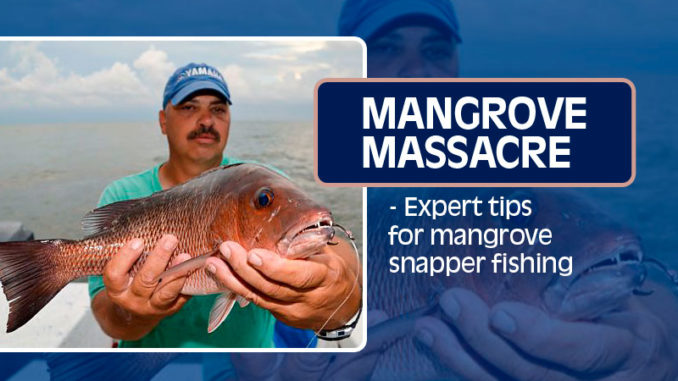
Mangrove snapper are known for being hook shy, but this veteran guide has the fish all figured out. So load up the boat with your buddies, head to the rigs and follow his advice to fill the box.
I knew Capt. Kenny Heikamp was pretty good. I watched him work while fishing on a shared charter when I was with the near-legendary Grand Isle charter skipper Bobby Terrebonne.
I asked Heikamp after the trip about doing a story on his specialty: mangrove snapper fishing.
The owner of Bentrod Fishing Charters (985-817-0117) was agreeable, but asked to put it off a year. He explained that he wanted to “round up a crew of people who know what they are doing.”
He wanted to show what could be done with these hard-fighting but spooky and finicky fish.
I realized how serious he was when he laid aside a weekend at the peak of the season; good-weather weekends are a dear commodity for offshore charter fishermen.
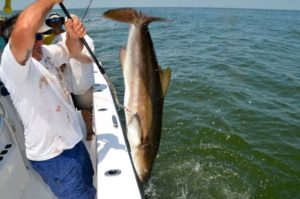
Joining Heikamp were six anglers: 50-year-old Richard and 22-year-old Trey Waller, a father-son team from Prairieville; 50-year-old Stanley Turner from Covington; 49-year-old Darryl Lopez of Mandeville; 47-year-old Rene Deshotel of Metairie; and 25-year-old Brady Mouton of Lafayette, who also doubles as Heikamp’s regular deck hand.
The boat was crowded.
On the way out the pass, Heikamp peered at me in the semi-darkness.
“You see how many people we got? I want that times 10 in fish,” he said.
There was enough light for me to see that he wasn’t grinning.
“Seventy mangrove snapper,” I thought to myself. “That’s a tall order; we’ll see.”
Our first stop, at a little after 6 a.m. was not far offshore — Grand Isle 48. I recognized it as a heavily fished platform.
That didn’t faze Heikamp. Neither did providing the rig number to an outdoor writer.
Things happened incredibly fast. I still hadn’t connected the faces in this crowd with names, let alone watched how they rigged and fished.
The first fish
At 6:10 a.m., a mangrove snapper came over the rail and Heikamp called out, “That’s the first one,” as he rolled up the No. 1 on his handy, dandy little fish counter.
By 6: 20 a.m., six mangroves were on board.
Gradually things began to take shape for me. Two things quickly stood out: They were all using live bait, and they were throwing very little chum.
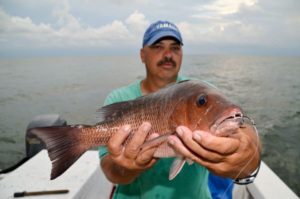 Chumming has almost become de rigeur among mangrove snapper fishermen. Not on Heikamp’s boat.
Chumming has almost become de rigeur among mangrove snapper fishermen. Not on Heikamp’s boat.
“I hate using chum,” he spat. “I believe that with chum you are feeding the fish you want to catch.”
Then he relented a bit.
“Sometimes you have to use a little to get the fish worked up,” Heikamp admitted.
The process
Mangrove snapper fishing in Louisiana has evolved into a process of one angler tossing broken or cut pieces of chum — usually pogies — toward one corner of a platform. As mangrove snappers dash out from beneath the platform to grab the chum pieces, other anglers on the boat make short underhanded flip casts to them with weightless hooks buried in a piece of chum.
After the hook drifts 10 or so feet away from the platform leg, the bait is retrieved for another mini-cast.
This is done over and over again, trying to fool a mangrove snapper into chomping on the chum piece with the hook in it.
It’s sight-fishing and, as such, demands clear water.
This isn’t at all what these guys were doing. They did cast as close as possible to a rig leg on one corner of the platform, but everything else was different.
They steadily began to feed out line after the bait hit the water, stripping it from the reels with their free hands.
The intent was to keep slack in the line at all times and allow the baitfish to go where it wanted and swim naturally.
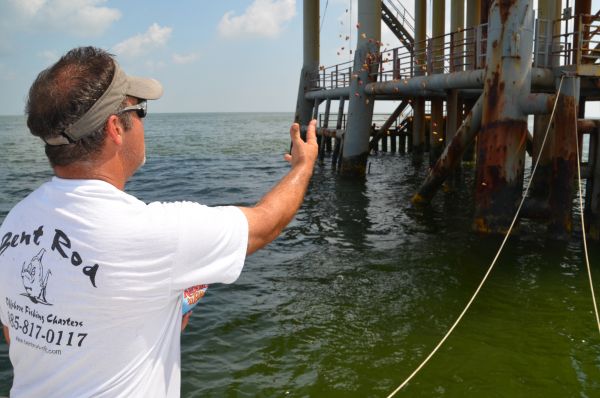
Sometimes, Heikamp explained, the mangrove snappers are right at the surface. Sometimes, they are 60 feet down.
On his reels with line counters, Heikamp has stripped off as much as 100 feet of line from the reel.
At first glance, it seemed insane — a sure guarantee for the line to be cut on the barnacle-covered pipe jungle down there.
But, amazingly, most of the time it worked.
A strike was indicated by one of three things:
- The line twitched
- The rod tip moved
- The bite was felt with the free hand that was feeding out line.
That’s when the fun started.
The action
The reel was slammed into gear and, at the same time, the angler with the fish on immediately and as quickly as possible walked toward the stern of the boat, ducking under the rods of all the other anglers who raised their rods to accommodate him and simultaneously work their way forward toward the bow — the best spot from which to fish.
Heikamp hectored his crew to move, move, move.
“If you don’t move your feet you lose your meat,” he said.
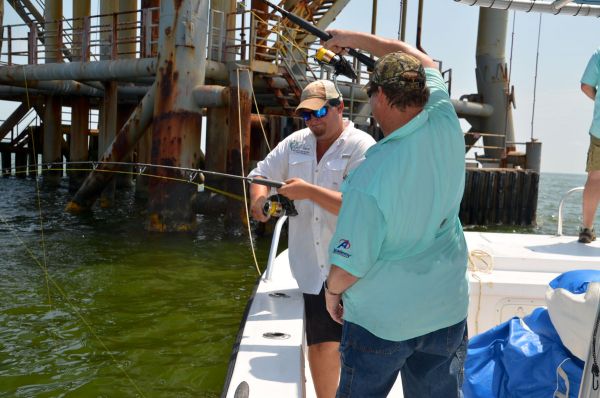
He explained that, for most people, the first instinct is to strike and after a moment start reeling, and only then start walking.
But you can walk faster than you can reel, he pointed out.
You have to get the fish away from the structure of the rig so you don’t get broken off, and you want to make room for the next guy on the bow.
He called this cycling arrangement “the circle of life.”
Frankly, it was well-orchestrated chaos quarterbacked by Heikamp. Five of the seven guys were big dudes; it was impressive to see a 260-pound bull of a man with a heavily bowed rod in his hands thundering toward the stern while the other guys gracefully wanded their rods over his head.
Heikamp’s eagle eyes didn’t miss anything. He constantly reminded the fishermen, in the midst of all the action, to mark their fish on the fish counter as they iced them.
“We don’t want to have to dig in the box to count them,” he said.
Dog food?
When the bite slackened considerably, Heikamp said he knew the problem.
“I think it’s because we lost too many fish,” he grunted. “I’m going to do something I don’t like too much: I’m going to chum a little to see if we can get them started again.”
He broke out a bag of, believe it or not — Kibbles ’n Bits dog food — and tossed a couple of handfuls toward the rig leg.
At 7:30 a.m., Coach Heikamp looked at the fish counter and urged his crew on.
“That’s only 21,” he said. “We got a long way to go.”
The men were experiencing a lot of break-offs fishing as close to the rig as they were with all the slack in their lines.
“Be ready to tie on a lot of hooks when you do this,” he growled.
“Yeah, bring plenty of hooks,” chimed in Richard Waller, an experienced mangrove snapper fisherman in his own right.
Shortly thereafter, a rig worker came down the platform’s lower deck and asked the boat to leave for a bit because of the need to bleed off some flammable gas.
Heikamp was unperturbed: He simply moved the boat a short hop to Grand Isle 47A.
The twin platform already had two boats on it, soon joined by a third and then a fourth, besides Heikamp’s.
“The other boats don’t bother me,” he said with a crooked grin. “I am probably doing other things than them.
“I don’t own these rigs. Plus, I want everyone to catch fish.”
Non-stop fishing
The father-and-son Waller team had almost instant hook-ups. Son Trey had the hottest hand so far in the morning and was also the youngest one aboard, so he received special abuse from the rest of the team.
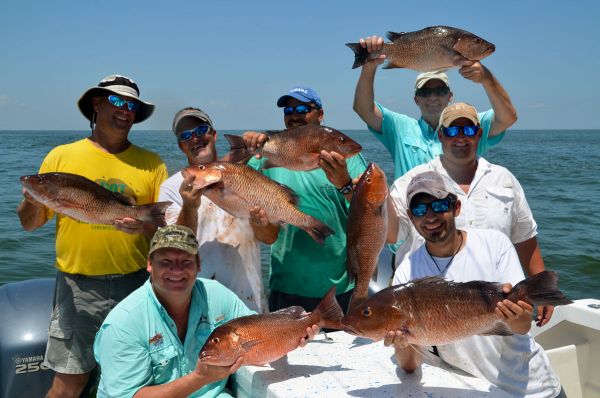
But everyone was jerking everyone else’s chain every chance they got, which was a lot. Even the skipper got his share.
When Heikamp hooked a good fish and charged to the back of the boat, Lopez irreverently counseled him.
“Come on, come on,” Lopez called. “Put up your purse and reel, Kenny.”
The day faired off beautifully after the morning started ugly, with the boat seemingly surrounded by vicious-looking squalls. A gentle breeze under mostly blue skies, produced at best a 1- to 2-foot chop.
Best of all, water currents were light.
“If the current is running 7 knots, I won’t even drop a bait,” Heikamp said. “The bait never gets a chance to go down, and the fish hold a lot tighter to the rig.”
The water was a dingy green, not what most mangrove snapper fishermen would like. But then again, these guys weren’t sight-fishing.
The bite was good, but they soon got interrupted again: A big supply boat approached the rig ominously.
A quick check on the radio confirmed that the boat needed to go to the very spot they were fishing.
The double platform was plastered with five other fishing boats by then, but Heikamp moved his boat to an opposite side of the platform, holding it in gear in reverse against the water current.
Expert pitching off the bow didn’t produce a single hit. Heikamp quickly lost patience and moved the boat to another rig in the Grand Isle 40s.
“I haven’t fished this one in a year, but we’ll try it,” he said.
A good move
They started hammering mangrove snappers immediately. By 10 a.m. they were up to 50 fish, some up in the 9-pound range. Then the first bonus fish came over the rail — a smallish, 18-pound cobia.
A few snapper later, Darryl Lopez connected on a 50-pound cobia. This was followed quickly by Brady Mouton with another big cobia.
Meanwhile everyone else was busy with mangrove snappers.
This was degenerating into a seven-ring circus. Big guys galloped toward the stern, dragging big snappers away from the rig and scattering the other anglers like chaff. Big fish slammed on the deck with meaty thuds.
Then Heikamp got in the game, adding another 50-pound cobia.
The deck was a slimy, bloody mess. Heikamp had scattered blood everywhere while he vigorously subdued the cobia with his metal baseball bat.
When he wasn’t clubbing cobia, he was using the bat to beat some sense into the numerous sharks that were brassy enough to grab the men’s live baits.
Then it was over.
Heikamp had rolled the big No. 70 up on his fish counter.
“This is a mangrove-massacring crew,” he croaked, with his chin stuck out beneath a smug grin.
It was 12:04 p.m. and we were only 14 miles from Caminada Pass.
We made it to Grand Isle in time for lunch.
Live bait is the ticket for mangrove fishing
Capt. Kenny Heikamp, like many other fishermen, believes mangrove snappers are wary fish and learn quickly how to avoid danger.
This is especially true out of Heikamp’s home base of Grand Isle, the closest thing Louisiana has to a fishing resort.
Mangrove snappers there get exposed to fishing pressure virtually every day during the April-to-September season.
They aren’t a hard fish to locate: Every offshore oil and gas platform is a signpost.
To expose them to even more pressure, mangrove snappers are the snapper species located closest to shore, making them more accessible to fishermen in smaller boats and during marginal weather.
Constant pressure and clumsy bait presentations by poorly skilled anglers, compounded by numerous break-offs when fish dive into the maze of sharp, barnacle-covered rig legs, give Grand Isle-Fourchon mangrove snappers a PhD in how to avoid getting caught.
Amongst other tactics, Heikamp has resorted to using live bait. For our trip, his boat had 60 pinfish and 200 croakers in the live well when it left the dock that morning.
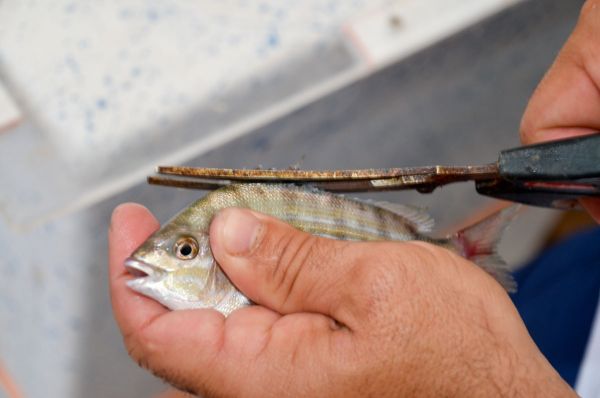 Richard and Trey Waller caught the pinfish from the Bridge Side Marina dock the night before the trip, using small hooks and squid for bait. The croakers were purchased from the marina.
Richard and Trey Waller caught the pinfish from the Bridge Side Marina dock the night before the trip, using small hooks and squid for bait. The croakers were purchased from the marina.
Heikamp explained the difference in the two baits.
“Croakers dive more than pinfish because they are bottom fish,” he said. “Pinfish are strong swimmers and can elude mangroves better. If the snappers aren’t aggressive, pinfish don’t work as well as croakers. But pinfish hold better in the livewell.
“Both are dang-good baits.”
Heikamp and several of the fishermen doctored their pinfish before using them by taking a pair of scissors and snipping off their dorsal (back) fins.
“It cuts their defenses off,” Heikamp said with a grin. “I learned about spines. An old-timer I fished trout with was smoking me 5 to 1. He would turn away from me, but I could hear a little snap.
“He was snapping the horn off of the shrimp.”
Croakers were most often hooked through the back about two-thirds of the way back from the head to the tail.
“That’s to make them dive,” the detail-oriented captain explained.
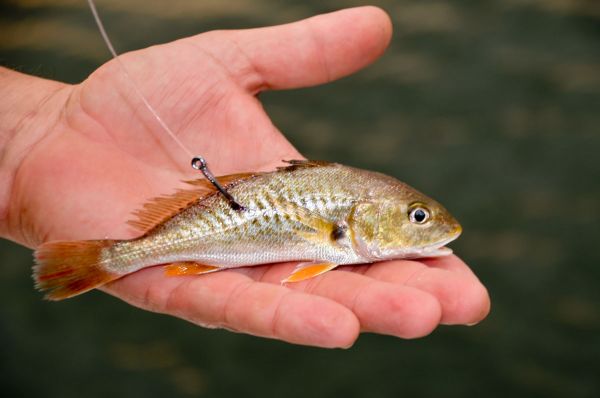
But this was an experienced crew, and they experimented constantly. Some hooked their baitfish through the rear of the bodies, some directly in the center of the fish and some even hooked them through the lips.
They even tried cut bait, taking slices of pogie. When they caught hardtails on the pogie, they cut them up for bait, too. Nothing was sacred.
“Be patient and experiment,” Heikamp coached.
The making of the master
Kenny Heikamp is built like a 5-foot, 7-inch coiled steel spring. He moves about his 32-foot Twin Vee catamaran with latent, ready to unleash energy. His chin has a determined set to it and his dark eyes burn intensely, like hot embers. I would hate to be a fish, knowing that he was after me.
The 43-year-old has operated Bent Rod Offshore Charters for 10 years, but his fishing roots go much deeper. When he was 16 and again when he was 17 years old, he worked whole summers on a commercial snapper boat out of Fourchon operated by Joey Toups. The third summer he spent commercial king mackerel fishing, also with Toups.
The offshore bug bit him bad. “It’s just you and Mother Nature out there,” he explained. You got to have your stuff together. The gulf will find your weaknesses. And the idea of dropping a line and not knowing what you are going to bring up turned me into an offshore fisherman.”
At 19, he became part of the Toups, Toups and Toups competitive king mackerel team in the Southern Kingfish Association (SKA). Joey Toups ran the team. His brother Anthony Toups funded them. The third Toups, one unrelated to the first two, was Raymond Toups, whose day job was being the Executive Chef at the Omni Royal Orleans Rib Room in the New Orleans French Quarter.
Heikamp fished with them in the SKA for 9 years while he worked for a refrigeration company. “It was a good experience,” he said. “It opened my eyes about how serious people can get about money and fishing.”
Never one to leave a moment free without fishing, Heikamp, when he wasn’t working refrigeration or kingfishing, worked as a deck hand on the Toups’ charter boat. Red snappers, before regulators choked the life out of the fishery, were a big deal in those days. They also fished for mangrove snappers, amberjacks, mahi, and some tuna.
After parting with the Toups, he bought three boats, a bay boat and two offshore boats for fishing with family and friends. While he owned this third boat, a Scarab, he bought his federal charter fishing permits in 2000.
He began chartering in 2004. When asked about the 4 year gap between getting his permits and beginning to charter, he grinned. “I spent that time learning to be good.”
Heikamp did some interesting stuff during this “learning period.” He often slipped on a mask, flippers and snorkel and dove overboard while his friends on board fished for mangrove snappers at an offshore platform.
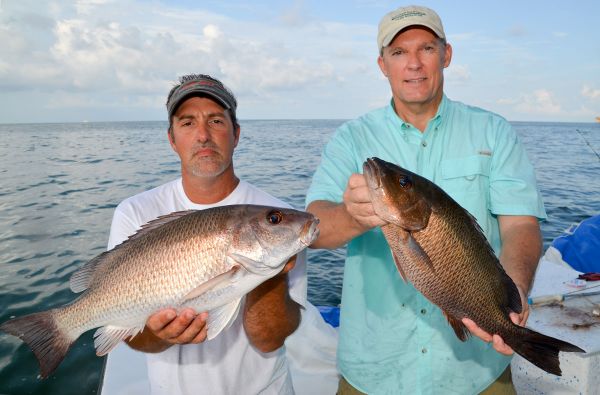 He watched the fish intently. “Mangroves would swim up to a bait and then swim away,” he said with a note of wonder still in his voice. “I learned that fish have a lot of patience. If it doesn’t look right, they don’t have to eat it.
He watched the fish intently. “Mangroves would swim up to a bait and then swim away,” he said with a note of wonder still in his voice. “I learned that fish have a lot of patience. If it doesn’t look right, they don’t have to eat it.
“Those baits didn’t seem to be working naturally, so I began to experiment. I said ‘let’s try fishing without a weight.’ Then I went to smaller hooks and then fluorocarbon line. I began to use better reels with smoother drags and stiffer rods to get the fish out of the rig.”
He also learned to respect the intelligence, eyesight, and adaptability of mangrove snappers. “When a fish broke off, it went straight to the furthest corner of the rig and it went deeper, sometimes out of sight. A lot of the other mangroves would follow it. Not all of them, but if there were 50 fish there, that one fish would take a quarter of them with it.
“It takes 15 minutes for things to get back to normal — unless you break off a bunch of fish. That can kill the bite. The end result for many fishermen is four or five fish a trip. They get frustrated and think we (guides) are lying to them.
“You know what else I learned from jumping in the water,” he smirked? “There’s a whole lot more fish down there than I expected.”